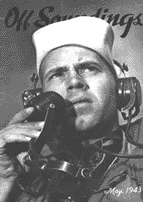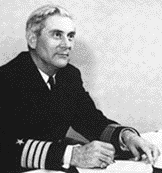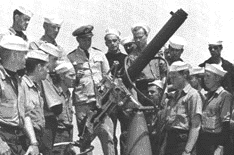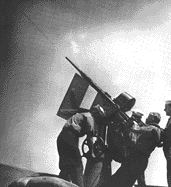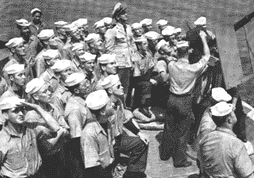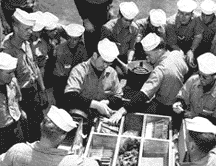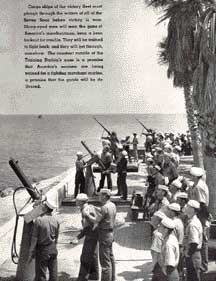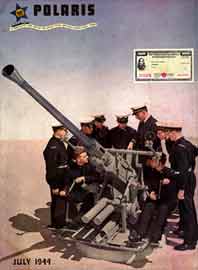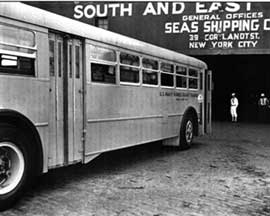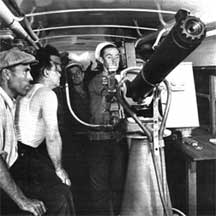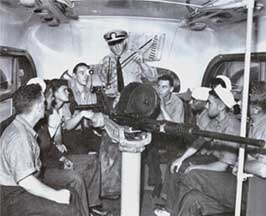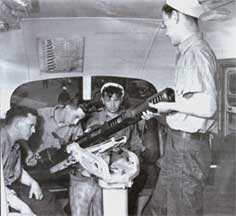General Quarters!
All Hands to Battle Stations!
General Quarters!Myth: The U.S. Merchant Marine of World War II only operated the ship, while the Armed Guard manned the guns!
Fact: The U.S. Merchant Marine of World War II was an Armed Force and the vessels were Armed Warships. Naval Armed Guard and Merchant Mariners worked as a team manning the guns.
U.S. Maritime Service Recruiting Poster, "Join the Fighting Men of the U.S. Merchant Marine" from National Archives
According to historian Bruce L. Felknor, editor, The U.S. Merchant Marine at War, 1775-1945:
"Merchant mariners who served at sea in World War II were denied recognition as veterans for 43 years. The major reason was a combination of misinformation, misunderstandings, and outright lies. One of the most influential of these was the argument that merchant seamen had nothing to with guns or firing at enemy vessels or planes."
On December 12, 1942, in a message for the dedication of the U.S. Maritime Service Training Station, Sheepshead Bay, NY, President Franklin D. Roosevelt stated:
"... the entire country joins me in wishing you every success and in paying tribute to you men of the Merchant Marine who are so gallantly working and fighting side by side with our Army and Navy to defend the way of life which is so dear to us all."
Admiral Albert J. Herberger, USN (Ret) stated:
During WWII, when were guns and gunners first put on U.S. ships?
"In the Pacific, long before war was declared, some enterprising ship crews built plywood "guns," hoping their profile would fool enemy ships. On November 17, 1941 Congress approved arming of merchant ships and set up the Naval Armed Guard. It took many months for guns and crews to get aboard thousands of ships. Many of the initial guns were of World War I vintage. Mariners in the Merchant Marine were trained at U.S. Maritime Service Training Stations, and at gunnery schools in Great Britain, Australia, and elsewhere. And, of course, they received on-the-job training while under attack. Mariners assisted the Naval Armed Guard in passing ammunition, catching cannon hot shells after firing wearing large asbestos gloves, and many were assigned anti-aircraft gun stations."Did the Merchant Marine receive military training and acquire a military capability?
"Yes, in early 1940 the Coast Guard began training the Merchant Marine personnel in gunnery and, in addition, the Merchant Marine Academy required extensive military training of their cadets to qualify for graduation. By November 1941 (in an act of Congress) our Government began to arm Merchant Ships and in December of that year, Navy armed guards were assigned to many vessels.""In responding to attack by the enemy, Navy personnel and Merchant Mariners fought together as a team --- they were members of the same gun crews. [emphasis added] The exchange of gunfire, especially in the first two years of the war was a daily routine for many of the Merchant vessels."
Battle Station Assignments and Gunnery Duties of Merchant Marine Crew
In February 1942, the Navy issued new instructions to Masters which stated there is no situation which permits a delay in opening fire on an enemy.Clarification of Gun duties and training of Merchant Marine Mariners aboard ship
War Shipping Administration Regulation, Washington, CONFIDENTIAL January 25, l943
On a typical cargo ship, 23 mariners out of a crew of 40-45 men were assigned gun stations during battle. This constituted full combatant status for the Merchant Marine.Confidential Message regarding Gunnery Training at British Ports
Indicates British concern of maintaining the safety of the lifeline of supplies to Britain. December 22, 1941Congressional Hearings Regarding Gunnery Duties
Committee on The Merchant Marine and Fisheries, House of Representatives, April 4, 1946
Instructions to Masters from the Secretary of the Navy, Frank Knox
Op-23L-JH (SC) S76-3 Serial 097923
NAVY DEPARTMENT, WASHINGTON
March 30, 1942
From: The Secretary of the Navy.
To : Master S.S. GEORGE DEWEY
7225 Gross Tons.
SUBJECT: Instructions for Scuttling Merchant Ships.1. It is the policy of the United States Government that no U. S. Flag merchant ship be permitted to fall into the hands of the enemy.
2. The ship shall be defended by her armament, by maneuver, and by every available means as long as possible. Then, in the judgment of the Master, capture is inevitable, he shall scuttle the ship. Provision should be made to open sea valves, and to flood holds and compartments adjacent to machinery spaces, start numerous fires and employ any additional measures available to insure certain scuttling of the vessel.
3. In case the Master is relieved of command of his ship, he shall transfer this letter to his successor, and obtain a receipt for it.
/s/ FRANK KNOX
_________________________
Received 3 September 1943
Port Director DateJacksonville, Florida [s] Edwin C. Kaminski
Port MasterCopy to: VCNO

Mariners were trained in gunnery at:
- U.S. Maritime Service Training Stations and U.S. Merchant Marine Academy
- Gunnery schools in the USA and Allied countries
- U.S. Navy Armed Guard Training Mobile Units
- Aboard ship by the Naval Armed Guard
- On-the-job training under battle conditions!
U.S. Maritime Service Training Station Gunnery TrainingThe United States Maritime Service, staffed by experienced officers of the United States Navy, Coast Guard and Merchant Marine, functioned directly under the War Shipping Administration and had the responsibility of recruiting, training and delivering competent crews to man the thousands of merchant ships built by the Maritime Commission.
"... America's seamen are being trained for a fighting merchant marine, a promise that the goods will be delivered... Give a Man a Gun and teach him how to use it."
Off Soundings, May 1943, published for trainees at the U. S. Maritime Service Training Station, Avalon, Catalina Island, California. Captain J. L. Beebe, U.S.N.R., Superintendent; Commander P. Brennan, U.S.N.R., Executive Officer
